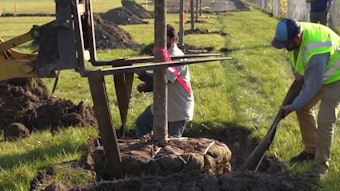
Many lawn care contractors see an expansion into tree and shrub care as a logical way to grow sales. But moving too fast with a "more is better" mentality can reduce your chances of doing it right.
At the 2013 Lawn Care Summit, Elliott Schaffer talked about how the tree and shrub care industry has somewhat lost its way, so to speak, over the past several years. As this service sector expanded, service providers began to adopt a philosophy that more applications would be better. After all, more applications means more sales, right? Not necessarily, according to Schaffer, who is the founder of Environmental Horticulture Services, a horticultural training and consulting business based in Dublin, OH.
"I'd like to see the industry get back to real customer consultations with trained horticulturists," Shaffer said. He'd also like to see tree/shrub care that is separate from lawn care—at least in the consumer's mind. Finally, he'd like to see service providers offer a menu of services, and reinvent themselves by creating unique niches.
Schaffer said that if you're thinking about adding a tree/shrub care service, consider his crawl/walk/jog/run approach.
Crawl. Offer two fertilizations (three if you're in the South or Pacific Northwest). This is a good first step because they're easy to schedule with existing lawn care customers, you probably don't need much in the way of new equipment, and you don't need licensing.
Walk. Here you build upon the Crawl stage by also offering one targeted pest application, or perhaps a deer repellent program. This gets a bit more complex as some level of expertise is required, as is additional licensing.
Jog. Here you now add a perimeter pest control by scheduling three or four treatments throughout the year. This offers some great advantages to you: potential for greater long-term profitability, customer really understands and appreciates "pest control."
Run. Now you're really hitting your stride, and you've decided to launch a tree and shrub operation as a stand-alone service. The advantages of doing this are the potential for greater long-term profitability, and the ability to afford your customers with the best in ornamental pest protection due to your heightened focus.
Potential disadvantages include tree/shrub being a diversion to your existing lawn care business, more capital expenditure requirements, more investment in training and management, and more marketing needs in order to build up a substantial customer base.
What could a full-season program look like?
Late winter – Dormant oil treatment to take care of over-wintering pests.
Early spring – Long-lasting fertilizer injected into root zone of all plants.
Mid spring – Plants individually treated to provide control of leaf miners, caterpillars and lace bugs, along with diseases such as leaf spot, rust and scab.
Early summer – Control of summer insects including scales, weevils, mites and beetles. Disease control continues for any lingering spring leaf diseases as well as powdery mildew.
Late summer – Closely monitor the landscape. Insects and diseases treated as needed.
Fall – Root-zone fertilizer injection.



























